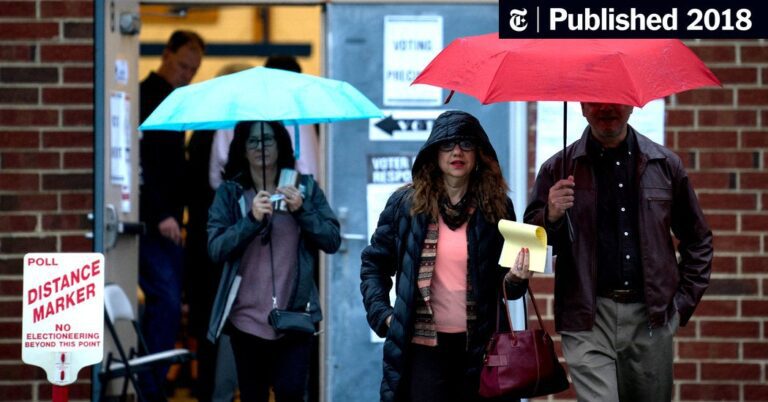Thunderstorms are expected to hit much of the eastern United States on Tuesday, which could reduce Election Day turnout in some places.
A strong cold front could bring rain and wind anywhere along the East Coast, from the Florida Panhandle to Maine, said Tim Loftus, data scientist and meteorologist at AccuWeather. Severe thunderstorms are likely from North Carolina to South Jersey. And in the Northeast, especially in New York and Pennsylvania, winds could reach 50 mph, Mr. Loftus said.
The same widespread storm system is expected to bring a mix of rain and snow to the Great Lakes and Northern Plains, including parts of Michigan, Minnesota and North Dakota.
“Pretty much the entire eastern half of the country” will be affected, said Ari Sarsalaris, a Weather Channel meteorologist. Much of the I-95 corridor will be rainy and the wind will be particularly bad in the Midwest, including the Great Lakes region and the Ohio Valley.
Multiple studies have shown that bad weather on Election Day can reduce turnout, which in turn tends to help Republicans because the groups most likely to be turned off from voting are the ones that tend to vote Democratic. But a more recent study, was published last November in the journal American Politics Research, found that the political effects of election day storms can go beyond turnout. Among voters who do turn out, one of the study's co-authors said, slightly more tend to vote Republican when the weather is bad.
“Not only whether you vote, but how you vote can be affected by the weather,” said co-author Yusaku Horiuchi, a professor of government at Dartmouth. “When the weather is bad, it affects people's mood. People tend to be more risk averse. When people are more risk averse, people are more likely to be more conservative and therefore more likely to vote Republican over Democrats.”
This effect is small, Professor Horiuchi pointed out. He and his co-author, Woo Chang Kang of the Australian National University in Canberra, estimated that about 1 percent of voters were likely to change their minds because of bad weather, which can translate into an increase of about three percentage points in a Republican candidate vote share — enough, in theory, to tip the balance of a close race.
While it is widely accepted as true that bad weather can lower turnout, and that lower turnout tends to benefit Republicans, this is not something Republicans tend to acknowledge publicly.
At a rally in Toms River, NJ, on Monday, however, Bob Hugin, a Republican challenging incumbent Democrat Sen. Robert Menendez, openly called the predicted rain “Republican weather.”
“This election is about who gets the vote and who doesn't,” Mr. Hugin said, “and I hope it rains hard tomorrow.”
Loftus and Sarsalaris noted, however, that in most places, at least part of the day will be dry, giving voters a more pleasant window.
The storm will generally move from west to east. In the Great Lakes and Ohio Valley, the worst is expected to come overnight and early Tuesday, with better weather Tuesday afternoon. This includes the Midwest as well as much of Kentucky, Tennessee, Pennsylvania and western New York.
In New England, eastern New York (including New York City), and the coastal mid-Atlantic, the storm will hit a little later. Voters where they have a choice may want to go to the polls in the morning.
In terms of turnout, Mr. Loftus said he was most concerned about North Carolina and Virginia, where storms are expected to eat up much of the voting hours.

